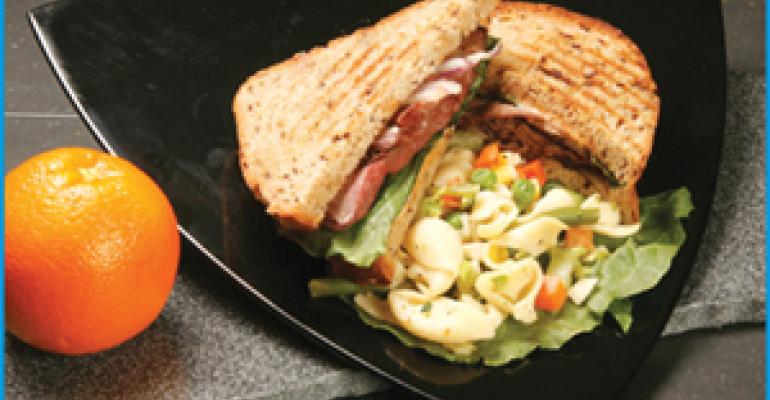With childhood obesity reaching what some experts call epidemic proportions, Chartwells School Dining Services has a mission to help schools serve students healthful, balanced meals.
Through a comprehensive program called Balanced Choices, Chartwells, a Rye Brook, N.Y.-based division of Compass Group’s Americas division, is dishing up more healthful options for lunch, snacks and beverages in the 550 school districts with which it has foodservice contracts across the United States.
“Schools can be part of the solution of the obesity crisis,” says Margie Saidel, director of nutrition for Chartwells’ K-12 division.
Introduced in January 2006, Balanced Choices takes a turnkey approach to wellness by providing schools with menus that do more than meet federal dietary requirements. The food is combined with educational tools to help students, school staff and parents embrace more healthful lifestyles.
“Research has shown there is not really one segment of society that can have an effect on our childhood obesity epidemic,” says Saidel, a registered dietitian with a master’s degree in public health whose position was created by Chartwells to increase its emphasis on healthy lifestyles. “It really needs to be a partnership with everyone.”
Elizabeth Fassberg, a New York-based nutrition consultant, praises the scope of Balanced Choices.
“We have moved so far away from thinking about food, and nurturing with food, and teaching our children about food, that if we can bring it back to a healthy approach, I think it is going to be better for everybody,” she says. “Kids will think better in school, they will feel better, and they will have more energy.”
Balanced Choices centers on a standard menu with 20 variations that take into consideration regional tastes and such practical matters as cost, availability of ingredients and existing inventory.
The lunches include a choice of an entrée, two vegetable or fruit side dishes and low-fat milk. The Balanced Choices options are identified with logos, and there are nutrition materials on hand in cafeterias and classrooms.
Many items are healthful twists on favorites like pizza and nachos, since children tend to shy away from foods they don’t know, Saidel says. Macho Nachos use low-fat Cheddar or low-fat American cheese, with lettuce and tomato. The health secret is a small portion of cheese. For lasagna and tacos, ground turkey is substituted for beef.
Popular flavor combinations determined by field surveys crop up in different guises. A Buffalo chicken wrap, with grilled white meat chicken, vegetables and a spicy low-fat ranch sauce, uses the same ingredients as Buffalo chicken pizza.
Chartwells serves some 1.5 million meals a day.
Program: Balanced ChoicesRollout: January 2006Company: Chartwells School Dining Services, a division of Compass GroupHeadquarters: Rye Brook, N.Y.Units: 4,000 schoolsRegion: nationalSample dishes: tricolor corn chips with fresh veggies and hummus; whole-wheat pasta with Italian meat sauce; Chicken Ranchero WrapPrice: $2.25 average for school lunches for grades 6-12Menu developers: in-house regional dietitians and chefs
“Our challenge was to come up with balanced meals and menus that would be attractive to students all over the country, since it was a national program,” Saidel says.
The process included soliciting menu suggestions from regional foodservice directors who shared their ideas with their assigned regional chefs and dietitians.
“We wanted to feel like we have a strong range of interests and appetites and ethnic diversity in the whole program,” Saidel says.
Fortunately, finding sources for more healthful ingredients on a large scale is getting easier, Saidel says. Chartwells’ director of menu management worked with the company’s food purchasing team to identify vendors.
“Manufacturers now are really getting the message and are coming out with some healthy alternatives,” she says.
The product development process involved tastings with the entire culinary and nutrition team. The dietitian would address the nutrition profile, and the chef would talk about the quality of food. Sometimes the manufacturer would be invited to participate. The meetings, with up to 20 in attendance, were held in Charlotte, N.C., at Compass Group’s U.S. headquarters.
Chartwells is constantly looking at new options and variations, Saidel says. Chefs work alongside dietitians to make sure nutrition requirements are being met and the items are easy to prepare.
Chartwells came up with a more healthful pizza by adding fresh vegetables and replacing canned pizza sauce with chopped fresh tomatoes.
Food costs have not increased, Saidel says. The nutrition software clients use has a cost analysis feature that helps them figure out how to manage costs. For example, they can replace one side for another if they have the ingredients on hand for an equally nutritious item, Saidel says.
Recipes are standardized to ensure consistency in yield and accuracy.
Special Report
“In our opinion, the key to keeping the menus successful is to enact a level of allowable modification,” Saidel says. “We encourage our chefs to inspire their own version of recipes to make them more fun, generation-appropriate and healthy.”




